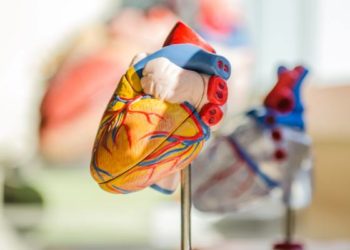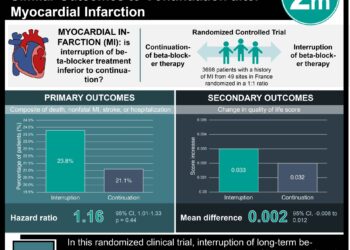Reinnervation of cardiac infarcts decreases subsequent arrhythmia incidence [PreClinical]
1. Genetically or pharmacologically blocking the tyrosine phosphatase receptor σ (PTPσ) in mice following myocardial infarction (MI) resulted in increased infarct reinnvervation and reduced arrhythmic heartbeats as compared to controls.
2. Mice lacking the PTPσ gene also avoided the MI consequences of increased variability in both action potential duration (APD) and intracardiac calcium transients.
Evidence Rating Level: 2 (Good)
Study Rundown: Patients surviving MIs are at increased risk for cardiac arrhythmias that can lead to sudden cardiac death. Recent research has correlated post-MI infarct denervation with risk of resulting serious arrhythmia. It is thought the sparse and heterogeneous innervation in the infarct hypersensitizes the cardiac β-adrenergic receptor (β-AR), resulting in heterogeneous sympathetic signal transmission (SST) throughout the heart and, ultimately, cardiac arrhythmias. Current clinical practice often uses beta blockers to target the β-AR and thus broadly decrease sympathetic signal transmission throughout the heart.
Here, researchers attempted instead to reduce post-MI arrhythmia incidence by reinnervating the infarct, and consequently reducing the heterogeneity of SST. Because scar denervation is caused by chondroitin sulfate proteoglycans (CSPGs), they targeted the CSPG receptor, PTPσ. Mice lacking the PTPσ gene (KO mice) showed hyperinnervation in the infarct region following MI, whereas heterozygous (HET) mice showed classic denervation in this region. KO mice showed significantly lower arrhythmia incidences than HET mice when subjected to the arrhythmia initiator isoproterenol (ISO) following MI. Similar results were obtained by pharmacologically targeting PTPσ with intracellular sigma peptide (ISP), which has been shown to promote reinnervation following spinal cord injury, days after the initial MI event. Additional experiments showed that KO mice were protected from MI-induced changes in the cardiac electrophysiology.
Rodent and human cardiac physiology have numerous differences that may blur the relevance of this study’s findings, and advancement to large animal studies is necessary before this reinnervation strategy can be translated to the clinical setting. Additionally, arrhythmias in MI survivors often take years to develop, resulting in a lengthy timeline for potential drug development. Despite these limitations, this work presents a promising new method for decreasing arrhythmia and sudden cardiac death in MI survivors.
Click to read the study in Nature Communications
Relevant Reading: Sympathetic stimulation increases dispersion of repolarization in humans with myocardial infarction
In-Depth [animal study]: To induce MI in mice, the left anterior descending coronary artery was reversibly ligated for 30 or 45 minutes. Sham surgeries served as controls. Following surgery, reinnervation of infarcts in KO and HET mice was visualized using immunohistochemistry. Heart tissue was double-stained with anti-fibrinogen antibodies, to identify infarcts, and anti-tyrosine hydroxylase (TH) antibodies, to identify sympathetic innervation. While infarct size did not differ between groups, TH staining was markedly greater in the KO group than in the HET group.
Arrhythmias were measured as the number of premature ventricular complexes (PVCs) per ISO injection at 10 days post-surgery. The HET mice exhibited significantly more PVCs per ISO injection (p<0.001, n=4 per group), while the KO mice performed similarly to mice that underwent sham surgeries. In the pharmacological studies, ISP-treated animals had fewer PVCs per ISO injection at 14 days post-surgery (p<0.05, n=4-5 per group).
In subsequent experiments, isolated hearts were perfused at physiological pressure and double-stained with a voltage-sensitive dye and an intracellular calcium dye. A pacing electrode in the left ventricular epicardium stimulated hearts at 150 ms intervals, and the APD at 90% (APD90) repolarization was measured over the entire heart. While mean APD90 was similar across all groups, the interquartile range of the HET MI group was higher than the KO MI and sham groups (p<0.01, n=4-5 hearts per group), demonstrating increased variability. Similarly, beat-to-beat fluctuations in the magnitude of calcium transients in the heart were much greater in HET-MI group when stimulated at 100 ms intervals (p<0.05, n=4-5 hearts per group).
Image: CC/Wiki/Patrick J. Lynch
©2015 2 Minute Medicine, Inc. All rights reserved. No works may be reproduced without expressed written consent from 2 Minute Medicine, Inc. No article should be construed as medical advice and is not intended as such by the authors, editors, staff or by 2 Minute Medicine, Inc.






